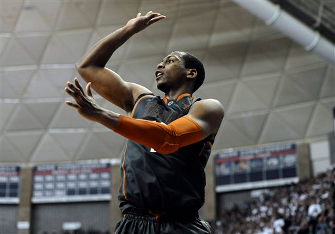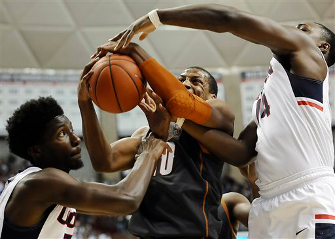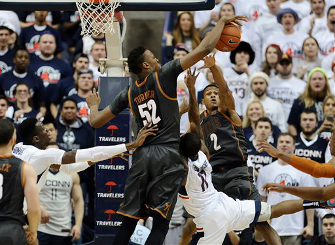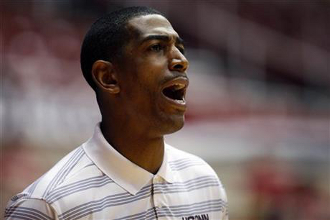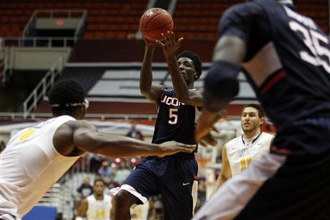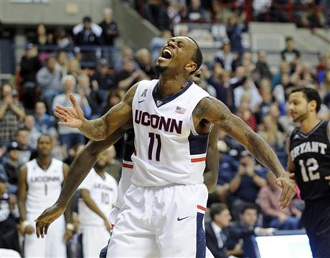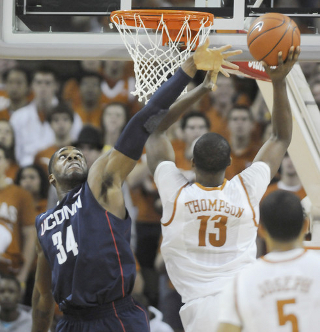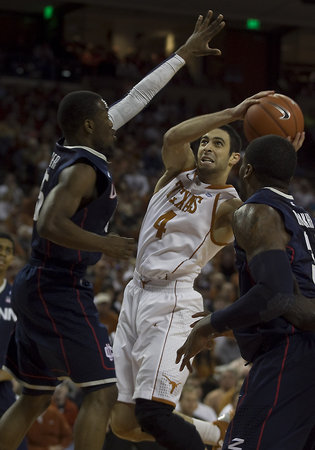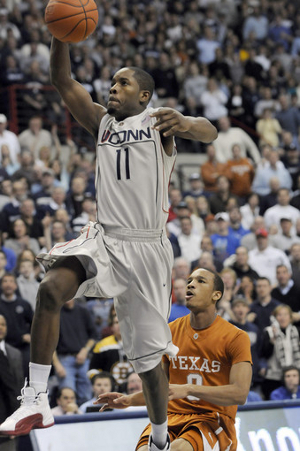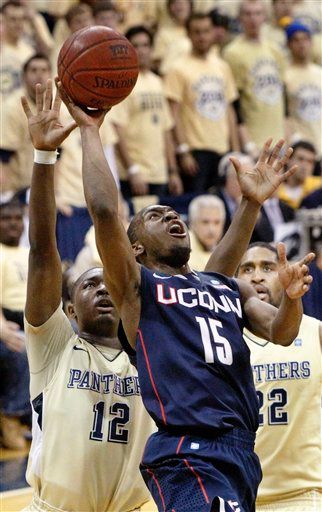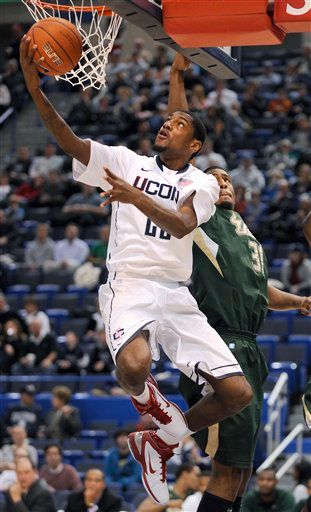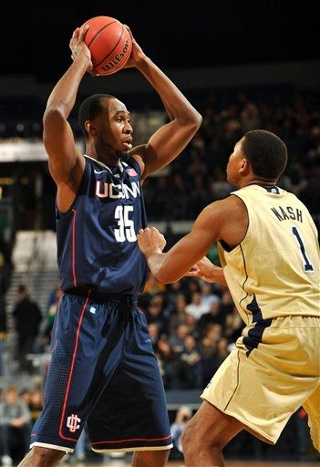Late in Sunday’s game in Storrs, it looked like the Longhorns were letting a golden opportunity slip away. Texas had built a lead as large as seven points just before the under-16 media timeout in the second half, but could only manage a trio of free throws over the next seven minutes. UConn wrestled momentum from the Longhorns and seemed poised to grind out another victory at home. Texas did not help its own cause as the minutes ticked away. Despite holding UConn to just one field goal in the final nine minutes of the game, the Longhorns continually found ways to turn the ball over and failed to secure crucial rebounds and loose balls, leading to a handful of free throws for the Huskies. Still, despite all of that, an unexpected free-throw miss by Ryan Boatright with 15 seconds on the clock left the door open for Texas. The Longhorns brought the ball up the court and ran a dribble weave about 25 feet from the basket as the seconds disappeared. Coach Rick Barnes started signaling for a timeout on the sideline, and it was granted with 4.4 to play, just before Javan Felix could hoist a desperation three from well beyond the NBA arc. After Texas drew up a play and came out on the floor, UConn’s Kevin Ollie surveyed the setup and called his own timeout.
Jonathan Holmes watches his game-winning three That set the stage for another round of Jonathan Holmes heroics. With the lanky Daniel Hamilton guarding Holmes, Demarcus Holland set a screen to free up the senior big man, while Myles Turner slipped through the mass of bodies and raced to the bucket. Holmes found himself alone in the corner, where Connor Lammert fed him for a wide-open look. UConn big man Amida Brimah had to leave Turner alone under the basket so he could challenge Holmes’ three, giving Texas an excellent opportunity to tip in a miss. It didn’t matter. Holmes, who leaned forward as he let the shot fly, splashed the game-winner with two seconds left on the clock. With the capacity crowd at Gampel Pavilion stunned into silence, Javan Felix stole the ball from UConn on the final play, sealing an improbable finish and victory for Texas. The win moves the Longhorns to 6-0 on the year, completing a perfect month of November. It was the team’s first spotless November and the program’s best start since the 2009-10 campaign, a season in which the Huskies were able to knock off Texas at Gampel. With another massive test looming for these Longhorns on Friday against the Kentucky Wildcats and their nine All-Americans, here are eight notes on the exciting Texas win: 1. Who said Rick Barnes can’t draw up a play in the huddle? The sideline OOB play set up the second career game-winner for Jonathan Holmes, providing a strikingly similar look to the one he drained against Kansas State in last year’s meeting at the Erwin Center. The play gave the Longhorns two solid options for a last-second shot, and left the team with an insurance play in Turner underneath the bucket. While the Texas offense has frequently gone stagnant for long stretches during games over the years, and Barnes has also earned a reputation with fans and the media as being an offensively-challenged coach, he does have a knack for giving his team a chance to win in the final seconds. Whether it be the two game-winners from Holmes, a great play for Ioannis Papapetrou in a 2003 double-OT thriller against Iowa State, or incredible clock management to force OT at Tech in 2003, Barnes has repeatedly shown that he can create a good look for his players in crunch time. 2. The stifling Texas D had the perfect gameplan The Huskies go as Boatright goes, and the Longhorns were well aware of that. Although Hamilton is undoubtedly a great scorer, the freshman has yet to prove that he can take over a game and carry his team to victory. Knowing that, the Longhorns made life very difficult for Boatright in the first twenty minutes, daring other UConn players to beat them. The decision to put Felix on Boatright was one that raised quite a few eyebrows in the minutes leading up to tip-off, but it paid off. Felix was able to stick with the senior guard, challenge his shots, and the Texas bigs were able to stifle Boatright’s drives when he did get past the perimeter defense. That resulted in a 4-for-10 first-half line for Boatright, with a pair of those makes having a high degree of difficulty. Although Boatright found it easier to score in the second half, and he was able to earn himself more trips to the stripe, the Longhorns still forced the rest of the Huskies into taking long jumpers. Sam Cassell, Jr. finished 2-for-11 from the field, including just 1-of-7 from long range. That defense kept Texas in the game as the offense scuttled through the second half. As previously mentioned, the Horns allowed just one bucket over the final nine minutes of play, while UConn had to rely on free throws — three of those coming as Texas was forced to foul in the final thirty seconds — for their final five points. In the end, Texas held the Huskies to 30.4% shooting on the afternoon, while allowing just 0.885 points per possession. The Horns still boast the nation’s fourth-best defense through six games, limiting opponents to an adjusted 0.868 PPP, according to Ken Pomeroy. 3. Texas must take the good with the bad from Felix On a team with a healthy Isaiah Taylor, Felix would likely be a role player who could provide some quality defense, knock down a few shots, and dish a few dimes every night. Instead, he has been thrust back into a point guard role on a team that desperately needs a slashing guard with a good stroke. Forced to be something he’s not, Felix has put Texas fans on a roller-coaster ride in the last three games. In the win over UConn, that meant that while Felix played solid D on Boatright early, canned an important three in a run at the end of the first half, and logged four assists, he also gave Longhorn fans numerous ulcers. Felix was only officially dinged for two turnovers on the afternoon, but that number did not include the handful of transition threes he clanked, or the shot clock violation charged to the team when he was on the court. Felix finished 2-for-8 from behind the arc, and is now 31.5% from the field in his two games at the point, with an effective field goal percentage of 39.5%. In the three games where Felix was able to spend more time off the ball, he was 43.5% from the field and posted an eFG of 52.2%. Once Taylor returns, it stands to reason that Felix will again see his numbers improve. Until then, he needs to focus on being a facilitator and must value the ball and his team’s possessions.
UConn made things difficult inside for Texas 4. Texas will have to develop a midrange game Although having Taylor back will certainly open up some things inside due solely to his ability to create off the bounce, the Longhorns will also need to utilize a midrange game to keep opponents honest. If not, they will see more of what UConn was able to do on Sunday afternoon, packing the lane to neutralize the Longhorn bigs and force the Horns to beat them from outside. Both Holmes and Lammert have the ability to knock down triples, along with midrange jumpers from the elbow or baseline. Turner has also shown range all over the court, so he would be a viable option in those same areas. If opponents are going to double Texas bigs on the catch, the Horns will need to be able to put those three in a position to float out of the paint and make opponents pay. In addition to the versatile Texas frontcourt, the Longhorn guards also must be willing to take and able to make the midrange jumper when it presents itself. ESPN’s Kara Lawson rightly called out Holland for shying away from a midrange J late in the game, and until he or Felix start taking and making those shots, opponents will be able to sell out in an effort to limit the major advantage Texas owns down low. 5. Holland continues to emerge in Taylor’s absence Despite passing up the midrange opportunities, Holland once again stepped up with Taylor out of the lineup. In addition to his well-advertised defensive skills, Holland has been on the lookout for driving opportunities since the team’s point guard went down, and his aggressive plays gave Texas early, easy buckets against UConn. The junior guard repeatedly made it to the rack as he scored 10 first-half points on 5-of-6 shooting, but he was shut out the rest of the way. On the other end of the floor, Holland was tasked with guarding the indefatigable Boatright late in the game. Although Felix performed admirably against UConn’s best player, it was Holland who prevented Boatright and the Huskies from scoring a field goal in the game’s final minutes, keeping it within reach for Texas. And, of course, it should also be noted that it was Holland who set the key screen to free up Holmes for the game winner. While Holland’s emergence has been key for Texas over the last nine days, the Horns will be a much more complete team if he continues to attack when the opportunities present themselves, even after the return of Taylor. As previously mentioned, increased confidence in Holland’s midrange game would be another helpful development, but even just having him continue his output when Taylor returns would be a boon for the Horns.
Myles Turner made key plays in the final minutes 6. Turner came up big in crunch time It was a tough afternoon for the Texas bigs, as Cameron Ridley was limited to an ineffective 17 minutes and Turner struggled offensively against UConn’s suffocating interior D. None of that mattered when the pressure was on, though, as the freshman blocked three shots, secured two key defensive rebounds, and calmly sank two clutch free throws, all in the final three minutes. 7. Yancy is showing flashes, but still needs some seasoning With Taylor out and Felix missing Tuesday’s win over St. Francis, Yancy has seen a sudden upswing in his minutes. The sophomore guard has applied good defensive pressure on the perimeter and shown great burst in getting to the rack, but has still played erratically enough to make his time on the court an adventure. Against UConn, Yancy was tagged with three turnovers, none of them more costly than the offensive foul for which he was whistled with 13:27 to go. The Longhorns led by four at that point, but Yancy swung his elbows to clear space on the wing, making some contact with Boatright’s chin. By letter of the law, that resulted in a Flagrant 1, giving UConn two free throws and the ball. Although the Huskies could only capitalize on the free throws and not the extra possession, the mistake effectively killed the momentum for Texas and gave UConn enough life to slowly build a lead down the stretch. Yancy’s other turnovers were a result of getting a little too deep with the bounce against a set defense, something he needs to improve if he wants to maintain a key role. If he can learn to rein in that explosive speed with the ball, he can limit his turnovers in the future, while still providing some nifty slashes to the rack. If Yancy can’t find a way to do that this year, his role will significantly diminish once Taylor is available. 8. The Horns were outhustled to loose balls For the first time this season, the Longhorns were outrebounded, as the Huskies snagged 36 boards to just 35 for Texas. Many of those rebounds were painfully frustrating offensive boards that UConn won back, simply beating the Longhorns to the long caroms. The Horns repeatedly saw their defensive stops wiped out by those offensive boards, which led to 11 crucial second-chance points. Texas had a distinct size advantage inside, but was still often beaten by Kentan Facey and his nose for rebounds. On the long boards, which Texas typically hustled to win in their first five games, UConn was simply quicker to react. The Longhorns are going to force opponents into a lot of bad misses this season, but if they cannot close out those possessions with strong rebounding, it is going to lead to some back-breaking second chances. They will be especially harmful in low-possession games such as this one at UConn, where those extra looks almost cost Texas the game. Up next: vs. UT-Arlington (3-3); Tuesday, 7 P.M. CT (LHN) |








